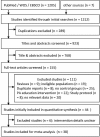How Does Physical Activity Intervention Improve Self-Esteem and Self-Concept in Children and Adolescents? Evidence from a Meta-Analysis
- PMID: 26241879
- PMCID: PMC4524727
- DOI: 10.1371/journal.pone.0134804
How Does Physical Activity Intervention Improve Self-Esteem and Self-Concept in Children and Adolescents? Evidence from a Meta-Analysis
Abstract
Objective: To perform a systematic review and meta-analysis for the effects of physical activity intervention on self-esteem and self-concept in children and adolescents, and to identify moderator variables by meta-regression.
Design: A meta-analysis and meta-regression.
Method: Relevant studies were identified through a comprehensive search of electronic databases. Study inclusion criteria were: (1) intervention should be supervised physical activity, (2) reported sufficient data to estimate pooled effect sizes of physical activity intervention on self-esteem or self-concept, (3) participants' ages ranged from 3 to 20 years, and (4) a control or comparison group was included. For each study, study design, intervention design and participant characteristics were extracted. R software (version 3.1.3) and Stata (version 12.0) were used to synthesize effect sizes and perform moderation analyses for determining moderators.
Results: Twenty-five randomized controlled trial (RCT) studies and 13 non-randomized controlled trial (non-RCT) studies including a total of 2991 cases were identified. Significant positive effects were found in RCTs for intervention of physical activity alone on general self outcomes (Hedges' g = 0.29, 95% confidence interval [CI]: 0.14 to 0.45; p = 0.001), self-concept (Hedges' g = 0.49, 95%CI: 0.10 to 0.88, p = 0.014) and self-worth (Hedges' g = 0.31, 95%CI: 0.13 to 0.49, p = 0.005). There was no significant effect of intervention of physical activity alone on any outcomes in non-RCTs, as well as in studies with intervention of physical activity combined with other strategies. Meta-regression analysis revealed that higher treatment effects were associated with setting of intervention in RCTs (β = 0.31, 95%CI: 0.07 to 0.55, p = 0.013).
Conclusion: Intervention of physical activity alone is associated with increased self-concept and self-worth in children and adolescents. And there is a stronger association with school-based and gymnasium-based intervention compared with other settings.
Conflict of interest statement
Figures





References
-
- Atlas WHO. Child and adolescent mental health resources: global concerns, implications for the future Geneva, Switzerland: World Health Organization; 2005.
-
- Belfer ML. Child and adolescent mental disorders: the magnitude of the problem across the globe. J Child Psychol Psyc. 2008; 49: 226–236. - PubMed
-
- Dishman RK, Hales DP, Pfeiffer KA, Felton G, Saunders R, Ward DS, et al. Physical self-concept and self-esteem mediate cross-sectional relations of physical activity and sport participation with depression symptoms among adolescent girls. Health Psychol. 2006; 25: 396–407. - PubMed
Publication types
MeSH terms
LinkOut - more resources
Full Text Sources
Other Literature Sources
Medical

